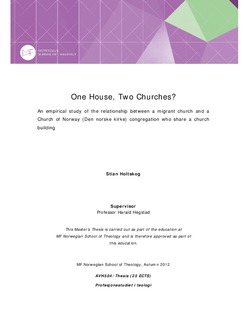| dc.contributor.author | Holtskog, Stian | |
| dc.date.accessioned | 2013-05-24T13:00:18Z | |
| dc.date.available | 2013-05-24T13:00:18Z | |
| dc.date.issued | 2013-05-24 | |
| dc.identifier.uri | http://hdl.handle.net/11250/161343 | |
| dc.description.abstract | This paper focuses on the phenomenon of migrant churches and indigenous churches sharing the same church building. It does so by presenting a case study of a Church of Norway congregation and a Ghanaian migrant church, both located in the Stovner church building. The paper explores and discusses the congregations’ understanding of each other, the joint
events held, and the significance of using a common space for services. Using theories of space and the theory of social capital, the thesis argues how joint activities and the use of a common space can create a new understanding of unity between congregations. Further, it investigates the possible role of such a relationship in social integration in wider Norwegian society. | no_NO |
| dc.language.iso | eng | no_NO |
| dc.subject | Ghanesiske menigheter | no_NO |
| dc.subject | Oslo | no_NO |
| dc.title | One House - two churches : an empirical study of the relationship between a migrant church and a Church of Norway (Den norske kirke) congregation who share a church building | no_NO |
| dc.type | Spesialavhandling | no_NO |
| dc.subject.nsi | VDP::Humanities: 000::Theology and religious science: 150::Theology: 151 | no_NO |
| dc.subject.nsi | VDP::Social science: 200::Sociology: 220 | no_NO |
| dc.subject.nsi | Immigrantmenigheter | no_NO |
| dc.subject.nsi | Den norske kirke | no_NO |
| dc.source.pagenumber | III, 86 | no_NO |
